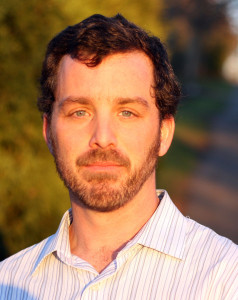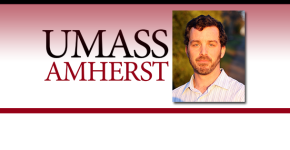
The term air pollution might evoke images of an industrialized city with many factories each with billowing smokestacks or a crowded freeway of cars pumping emissions into the atmosphere.
But, as Richard Peltier, assistant professor of environmental health sciences at UMass Amherst, will show us, everyone should be aware of air they breathe.
Dr. Richard Peltier is an atmospheric chemist and researcher in exposure science at the University of Massachusetts Amherst’s School of Public Health and Health Sciences in Environmental Health Science. He holds an MPH in environmental health science from Columbia University and a PhD in atmospheric chemistry from the Georgia Institute of Technology. His research interests are interdisciplinary and are at the interface of atmospheric sciences, public health and engineering. The main thrust of his research hypothesizes that specific chemical components of air pollution drive many of the observed health effects, and this can be assessed in both laboratory and ambient settings.
Indigenous Air Pollution
![]()
Wood fires evoke imagery of warmth and sustainability. But they are used for other purposes, too, particularly by indigenous populations. In First Nation Omushkego Cree tribes, on the shores of James Bay in Canada, subsistence hunting each spring and fall is a time-honored and culturally-relevant tradition, where families can travel hundreds of kilometers into the wild to hunt duck and geese. These communities use wood smoke to preserve their food, as well as for domestic heating and cooking.
Unfortunately, exposure to wood smoke is thought to be quite detrimental to human health, and our work has indeed shown levels in these communities well above World Health Organization recommendations for air pollutants.
Hunting is an integral part of their culture and tradition. It is very important for these communities to transfer this indigenous knowledge from elder to the young in order for these traditions to continue. There is a social component for these families as they carry out the smoking process, which can last for days or weeks. With all of this smoke, they are exposed to extraordinary levels of air pollution. During the coming fall hunting season, my colleagues and I will be taking part in an intensive community-based participatory research project on indoor air quality during these activities and possible mitigation strategies.
It is important to recognize the importance of these culturally-relevant activities to the community, but at the same time, we also know that they may lead to significant health concerns. We hope our efforts will identify easy-to-use techniques to reduce exposures to indoor air pollution while protecting traditional life ways.
Our work will analyze a range of air pollutants, as well as conduct a number of biological tests to measure the health effects on these populations. We hope this work will help identify impacts of pollution on native people and communities both in Canada and the United States, and will help empower these communities in measures to reduce health risks.
